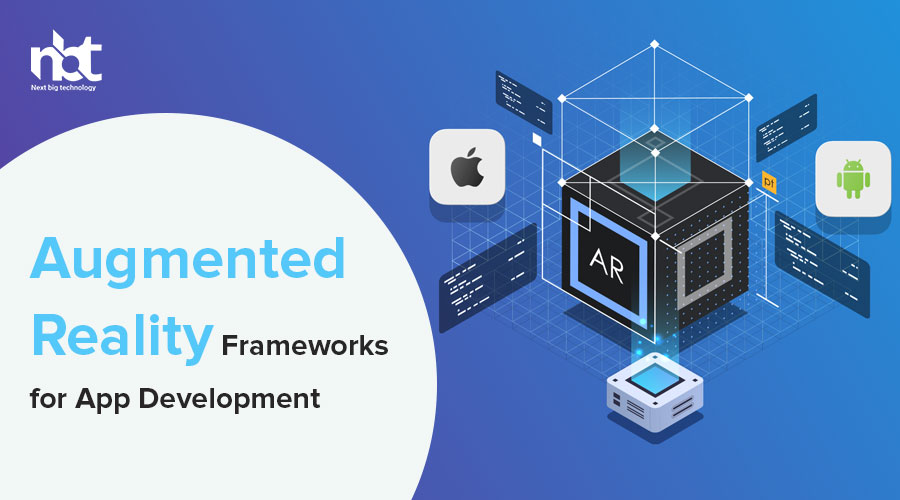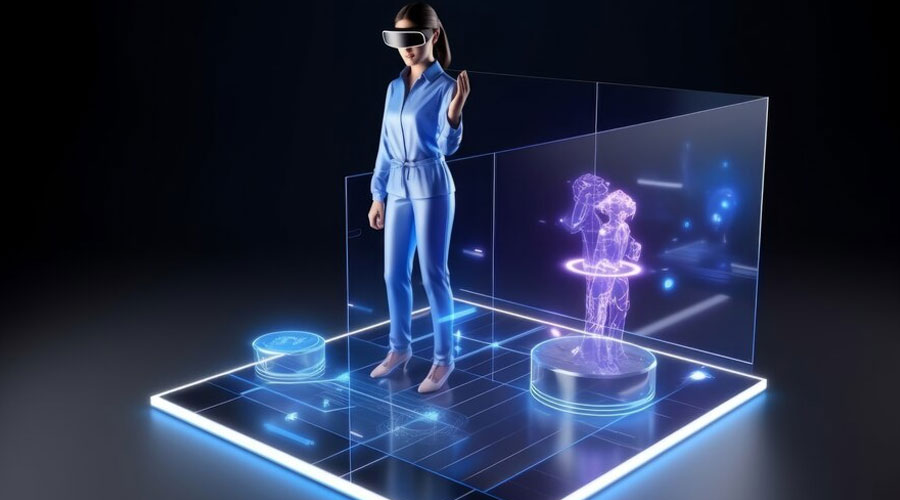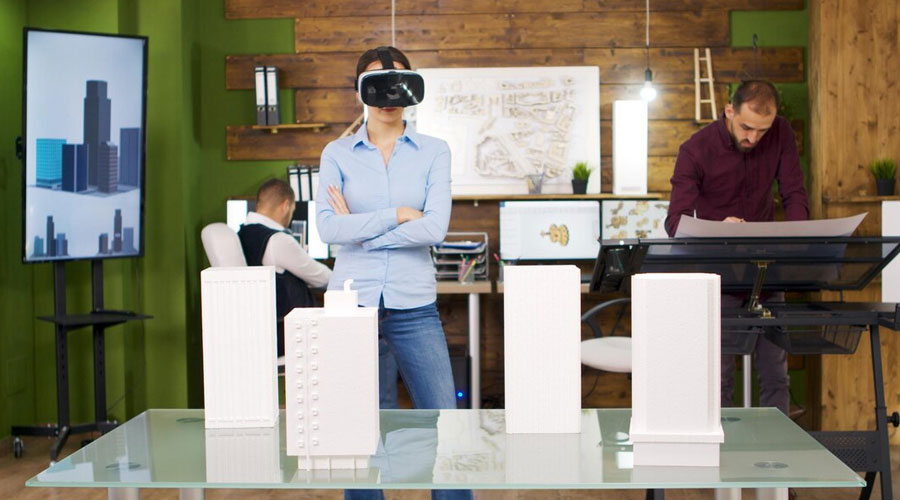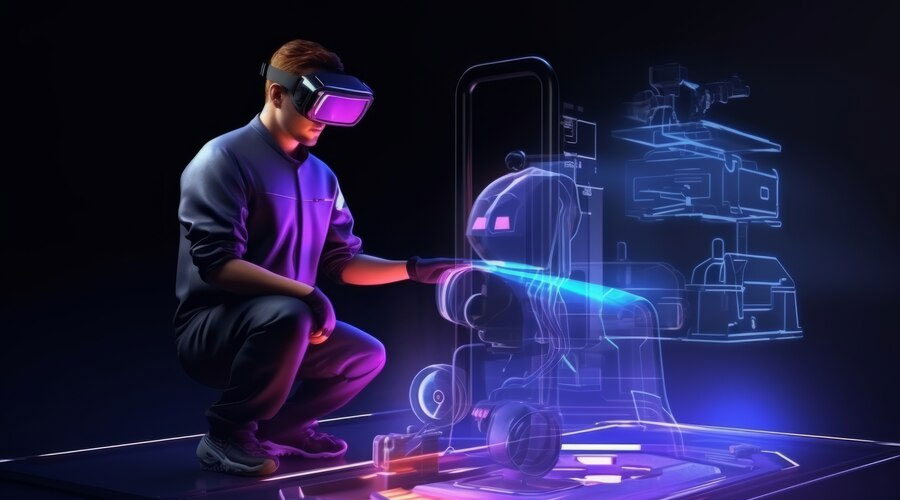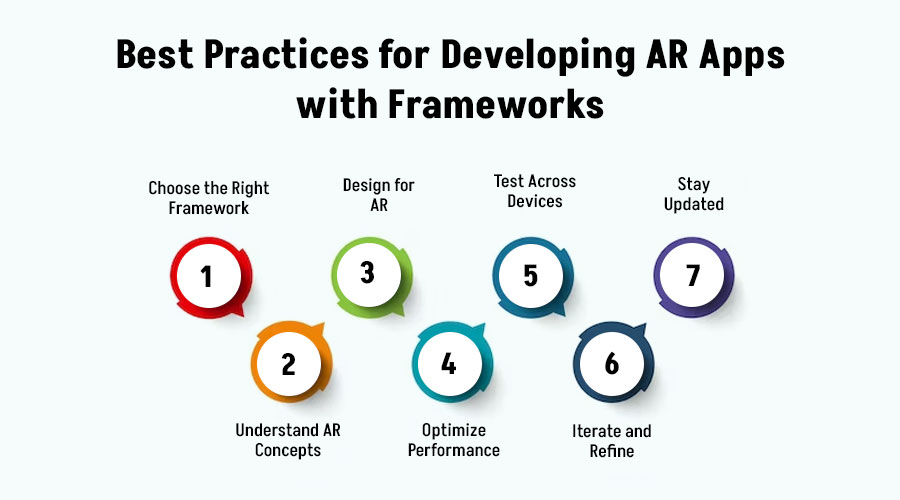Table of Contents
Introduction to Augmented Reality (AR) Frameworks
Augmented Reality (AR) has emerged as a revolutionary technology, seamlessly blending the virtual world with the real one, offering immersive and interactive experiences like never before. As AR gains momentum across various industries, understanding its frameworks becomes imperative for developers and enthusiasts alike. In this article, we delve into the world of AR frameworks, shedding light on their significance, functionality, and popular examples.
Understanding Augmented Reality Frameworks:
Augmented Reality frameworks serve as the backbone for developing AR applications. They provide developers with the necessary tools, libraries, and APIs to create immersive AR experiences efficiently. These frameworks simplify the development process by abstracting complex AR functionalities, enabling developers to focus on creativity and innovation.
Key Components of AR Frameworks:
- Tracking: AR frameworks utilize advanced algorithms for accurately tracking the position and orientation of real-world objects, enabling seamless integration of virtual elements.
- Rendering: Rendering is crucial for generating realistic virtual objects and overlaying them onto the real world. AR frameworks employ rendering techniques such as OpenGL and Vulkan to achieve high-quality visuals.
- Interaction: Interaction is vital for user engagement in AR applications. Frameworks offer intuitive gesture recognition and interaction modules, facilitating user input through gestures, voice commands, or touch.
- Integration: AR frameworks seamlessly integrate with various platforms and devices, including smartphones, tablets, and smart glasses, ensuring broad compatibility and accessibility.
Popular Augmented Reality Frameworks:
- ARKit (iOS): Developed by Apple, ARKit is a robust framework for building AR experiences exclusively for iOS devices. It offers advanced features such as world tracking, scene understanding, and face tracking, making it ideal for creating immersive iOS apps.
- ARCore (Android): Google’s ARCore is a powerful platform for developing AR applications on Android devices. It provides capabilities like motion tracking, environmental understanding, and light estimation, enabling developers to create compelling AR experiences for Android users.
- Vuforia: Vuforia is a versatile AR framework known for its marker-based and markerless tracking capabilities. It supports a wide range of devices and platforms, making it suitable for various AR applications, including gaming, education, and marketing.
- Unity3D: Unity3D is a popular game engine that offers robust AR development capabilities through its AR Foundation package. It provides cross-platform support, intuitive development tools, and extensive documentation, making it a preferred choice for both indie developers and enterprises.
Benefits of Using AR Frameworks in App Development
In the dynamic realm of mobile application development, staying ahead of the curve is essential for success. Augmented Reality (AR) has emerged as a transformative technology, reshaping user experiences across various industries. As businesses strive to engage users in innovative ways, integrating AR frameworks into app development has become increasingly popular. Let’s delve into the manifold benefits that AR frameworks offer in app development.
- Enhanced User Engagement: AR frameworks add a new dimension to user interactions, fostering immersive experiences. By overlaying digital content onto the real world, apps can captivate users in unique and compelling ways. Whether it’s exploring virtual worlds, visualizing products in a real environment, or gamifying experiences, AR elevates user engagement to unprecedented levels.
- Innovative Marketing Opportunities: Leveraging AR in app development opens up innovative avenues for marketing. Brands can create interactive AR experiences to showcase products, allowing users to virtually try before they buy. This not only enhances brand engagement but also drives conversions by providing a more immersive shopping experience.
- Increased Retention and Monetization: Apps integrated with AR frameworks often boast higher user retention rates. The captivating nature of AR experiences encourages users to spend more time within the app, thereby increasing ad impressions and in-app purchases. Moreover, offering premium AR features provides monetization opportunities, unlocking new revenue streams for app developers.
- Differentiation and Competitive Edge: In a crowded app marketplace, standing out is crucial for success. By incorporating AR capabilities, apps can differentiate themselves from competitors and carve out a distinct identity. AR-driven features not only attract users but also position the app as cutting-edge and innovative, enhancing its appeal in a competitive landscape.
- Seamless Integration with Existing Technologies: AR frameworks seamlessly integrate with other emerging technologies such as AI and IoT, amplifying their potential. This synergy enables developers to create truly immersive and intelligent experiences, where virtual elements seamlessly interact with the physical environment. Whether it’s enhancing navigation with AR overlays or integrating IoT data visualization, the possibilities are endless.
- Streamlined Development Process: Modern AR frameworks offer robust development tools and libraries, streamlining the app development process. Developers can leverage pre-built components and APIs to rapidly prototype and deploy AR features, reducing time-to-market. Additionally, the availability of comprehensive documentation and community support facilitates learning and troubleshooting, empowering developers to unleash their creativity.
- Scalability and Future-Proofing: Investing in AR frameworks ensures scalability and future-proofing for app development endeavors. As AR technology continues to evolve, frameworks evolve in tandem, offering new features and optimizations. By building on top of established AR frameworks, developers can future-proof their apps, ensuring compatibility with upcoming devices and technologies.
Key Features and Capabilities of AR Frameworks
Augmented Reality (AR) has emerged as a groundbreaking technology that overlays digital information onto the physical world, revolutionizing various industries including gaming, education, healthcare, and retail. At the heart of AR development lie robust frameworks, offering developers the tools and resources to create immersive AR experiences. In this article, we delve into the key features and capabilities of AR frameworks, shedding light on their significance in shaping the future of augmented reality.
- Cross-Platform Compatibility: One of the defining characteristics of top AR frameworks is their ability to support multiple platforms seamlessly. Whether it’s iOS, Android, or web-based AR experiences, developers benefit from frameworks that ensure compatibility across different devices and operating systems. This versatility expands the reach of AR applications, catering to a broader audience.
- Markerless Tracking: Modern AR frameworks leverage advanced computer vision algorithms to enable markerless tracking, allowing digital content to interact intelligently with the real-world environment. By detecting and analyzing features such as surfaces, objects, and spatial geometry, these frameworks deliver smooth and accurate AR experiences without the need for physical markers or QR codes.
- 3D Object Recognition and Tracking: Another crucial feature of AR frameworks is their ability to recognize and track three-dimensional objects in real-time. This capability opens up endless possibilities for interactive experiences, enabling users to interact with physical objects enhanced by digital overlays. From interactive product demonstrations to educational simulations, 3D object recognition adds depth and realism to AR applications.
- Environmental Understanding: Leading AR frameworks incorporate environmental understanding capabilities, allowing applications to perceive and interact with the surrounding environment intelligently. Through techniques like SLAM (Simultaneous Localization and Mapping), these frameworks enable AR content to maintain spatial awareness, adapt to changes in the environment, and deliver immersive experiences that blend seamlessly with the real world.
- Integration with Sensor Data: To enrich AR experiences, frameworks often integrate with a wide range of sensors available on modern mobile devices. From GPS and accelerometers to gyroscopes and depth sensors, these frameworks leverage sensor data to enhance spatial awareness, enable precise positioning, and create immersive interactions that respond to real-world conditions.
- Extensive Libraries and Tools: AR development frameworks offer developers access to comprehensive libraries and tools, empowering them to streamline the development process and unleash their creativity. These libraries may include pre-built components for common AR functionalities, such as gesture recognition, physics simulations, and 3D rendering, accelerating development and reducing time-to-market.
- Support for Rich Multimedia Content: The best AR frameworks support a variety of multimedia formats, including 3D models, animations, videos, and audio, allowing developers to create captivating AR experiences that engage multiple senses. Whether it’s overlaying virtual characters in the physical space or displaying informative visualizations, support for rich multimedia content is essential for creating compelling AR applications.
- Community and Developer Support: A vibrant developer community and robust support ecosystem are essential aspects of any AR framework. Developers benefit from forums, documentation, tutorials, and online communities where they can seek guidance, share knowledge, and collaborate on projects. This collaborative environment fosters innovation and accelerates the evolution of AR technology.
Comparison of Popular AR Frameworks
In the dynamic world of Augmented Reality (AR), developers are constantly seeking efficient frameworks to bring their ideas to life. With an array of options available, choosing the right AR framework can be a daunting task. In this article, we’ll delve into the comparison of some of the most popular AR frameworks, shedding light on their features, capabilities, and suitability for various projects.
- ARKit (iOS):
- Developed by Apple, ARKit is a powerful framework exclusively for iOS devices.
- Known for its seamless integration with Apple’s hardware and software ecosystem, ARKit offers high-quality AR experiences.
- Features like plane detection, face tracking, and world tracking make it ideal for creating immersive AR applications.
- However, its compatibility limited to iOS devices is a drawback for developers targeting multiple platforms.
- ARCore (Android):
- Google’s ARCore is the counterpart of ARKit, designed for Android devices.
- It provides robust features such as motion tracking, environmental understanding, and light estimation.
- ARCore’s wide device support makes it accessible to a broad user base, contributing to its popularity among developers.
- The framework is constantly evolving, with regular updates and improvements enhancing its functionality.
- Vuforia:
- Vuforia is a widely used AR platform known for its versatility and ease of use.
- It supports multiple platforms, including iOS, Android, and Unity, making it suitable for cross-platform development.
- Vuforia offers advanced features like object recognition, image tracking, and occlusion, enabling developers to create sophisticated AR experiences.
- Its extensive documentation and community support make it a favorite among both beginners and experienced developers.
- Unity AR Foundation:
- Unity AR Foundation is a part of the Unity game engine, allowing developers to create AR applications with Unity’s familiar interface.
- It offers cross-platform compatibility, supporting both ARKit and ARCore, as well as devices like HoloLens and Magic Leap.
- Unity’s rich ecosystem provides access to a vast library of assets, plugins, and resources, streamlining the development process.
- With Unity AR Foundation, developers can leverage Unity’s powerful features for creating interactive and engaging AR content.
- Spark AR Studio:
- Developed by Facebook, Spark AR Studio is a user-friendly platform for creating AR effects for Facebook and Instagram.
- It offers a wide range of features such as face tracking, segmentation, and animation tools, empowering creators to craft immersive AR experiences for social media platforms.
- Spark AR Studio’s integration with Facebook’s ecosystem provides access to a large audience, making it an attractive choice for brands and marketers.
Unity AR Foundation: A Comprehensive Overview
In the dynamic landscape of augmented reality (AR) development, Unity AR Foundation stands out as a powerful toolset that empowers developers to create immersive AR experiences seamlessly. With its robust features and user-friendly interface, Unity AR Foundation has become the go-to framework for building AR applications across various platforms. Let’s dive into a comprehensive overview of Unity AR Foundation and explore its key components, functionalities, and advantages.
Understanding Unity AR Foundation:
Unity AR Foundation serves as a bridge between Unity and AR platforms like ARKit and ARCore, allowing developers to write AR applications once and deploy them across multiple devices and platforms effortlessly. It provides a unified API that abstracts the underlying complexities of different AR technologies, enabling developers to focus on creating engaging AR content rather than dealing with platform-specific intricacies.
Key Components of Unity AR Foundation:
- AR Subsystems: AR Subsystems are modular components that interface with AR platform-specific features such as motion tracking, environmental understanding, and light estimation. Unity AR Foundation supports ARCore for Android devices and ARKit for iOS devices, offering seamless integration with these platforms’ capabilities.
- AR Anchors: AR Anchors allow developers to place virtual content in the real world with precision. Whether it’s placing virtual objects on horizontal surfaces like tables or vertical surfaces like walls, AR Anchors ensure accurate positioning and persistence across AR sessions.
- AR Raycasting: AR Raycasting enables interactions with virtual content in the AR environment. By casting rays from the device camera into the scene, developers can detect intersections with virtual objects, surfaces, or planes, facilitating user interactions such as tapping, dragging, and gesturing.
- AR Remote: AR Remote simplifies the development process by enabling real-time debugging and testing of AR applications directly on the device. Developers can iterate quickly and efficiently, making adjustments to their AR experiences without the need for repeated builds and deployments.
Advantages of Using Unity AR Foundation:
- Cross-Platform Compatibility: Unity AR Foundation allows developers to build AR applications that run seamlessly across iOS and Android devices, leveraging the capabilities of ARKit and ARCore. This cross-platform compatibility ensures broader reach and maximizes the audience for AR experiences.
- Ease of Development: With its intuitive interface and unified API, Unity AR Foundation streamlines the AR development process, reducing development time and complexity. Developers can focus on unleashing their creativity and innovation without being bogged down by platform-specific nuances.
- Community Support: Unity AR Foundation benefits from a vibrant community of developers, enthusiasts, and experts who contribute resources, tutorials, and plugins to enhance the framework’s capabilities. The wealth of community-driven support ensures that developers have access to a vast knowledge base and can seek assistance when encountering challenges.
- Future-Proofing: As AR technology continues to evolve rapidly, Unity AR Foundation remains at the forefront of innovation, consistently adapting to support emerging AR platforms and technologies. By leveraging Unity’s extensive ecosystem and updates, developers can future-proof their AR applications and stay ahead of the curve.
ARKit: Apple’s Framework for iOS AR Development
In the realm of cutting-edge technology, augmented reality (AR) has emerged as a revolutionary concept, blurring the lines between the digital and physical worlds. And at the forefront of AR innovation stands ARKit, Apple’s robust framework dedicated to powering AR experiences on iOS devices. In this article, we delve into the intricacies of ARKit, exploring its features, capabilities, and its pivotal role in shaping the future of mobile AR development.
Understanding ARKit: A Brief Overview:
Launched in 2017 alongside iOS 11, ARKit swiftly gained traction among developers for its seamless integration with existing iOS technologies and its ability to deliver immersive AR experiences on iPhones and iPads. Built upon a foundation of computer vision, motion tracking, and scene understanding, ARKit empowers developers to overlay digital content onto the real world with remarkable precision and realism.
Key Features and Capabilities:
1. World Tracking: ARKit leverages the device’s camera and motion sensors to accurately track the device’s position and orientation in real-time, enabling virtual objects to interact convincingly with the physical environment.
2. Scene Understanding: Through advanced algorithms, ARKit analyzes the scene’s geometry and detects key features such as surfaces, edges, and lighting conditions, facilitating realistic occlusion and blending of virtual content with the real world.
3. Lighting Estimation: ARKit dynamically adjusts the virtual objects’ lighting to match the surrounding environment, ensuring seamless integration and enhancing the overall visual fidelity of AR experiences.
4. Object Detection and Tracking: ARKit enables developers to recognize and track specific objects in the real world, opening up possibilities for interactive AR applications such as gaming, product visualization, and industrial maintenance.
5. Face Tracking and Augmentation: With ARKit’s sophisticated facial recognition capabilities, developers can create engaging AR experiences that respond to users’ facial expressions and movements, revolutionizing applications in entertainment, communication, and beyond.
Harnessing the Power of ARKit: Development Workflow:
Developing AR experiences with ARKit follows a streamlined process, encompassing scene creation, asset integration, scripting, and optimization for performance and user experience. Apple’s extensive documentation and resources, coupled with robust development tools like Xcode and Reality Composer, empower developers to unleash their creativity and bring their AR visions to life with ease.
The Future of ARKit and iOS AR Development:
As technology continues to evolve, so does ARKit. With each iteration, Apple introduces new features and enhancements, pushing the boundaries of what’s possible in mobile AR development. From improved spatial mapping to enhanced object recognition, ARKit is poised to revolutionize industries ranging from gaming and retail to education and healthcare, unlocking unprecedented opportunities for innovation and engagement.
ARCore: Google’s Framework for Android AR Development
Augmented Reality (AR) has emerged as a groundbreaking technology that seamlessly blends the digital world with the real world, opening up endless possibilities across various industries. Among the pioneers in this realm stands ARCore, Google’s revolutionary framework designed specifically for Android devices. With its robust features and versatile capabilities, ARCore is empowering developers to create immersive AR experiences that redefine the way we interact with technology.
Understanding ARCore: ARCore serves as Google’s platform for building augmented reality experiences on Android devices, offering developers a comprehensive set of tools and APIs to unlock the full potential of AR. Developed as a successor to Project Tango, ARCore is built on the foundation of three key components: motion tracking, environmental understanding, and light estimation. These elements work in tandem to enable devices to perceive and interact with the world around them, laying the groundwork for immersive AR experiences.
Motion Tracking: At the core of ARCore lies its advanced motion tracking capabilities, which enable devices to accurately track their position and orientation in real-time. By leveraging a combination of sensors such as accelerometers and gyroscopes, ARCore enables smooth and precise tracking of the device’s movement, ensuring that virtual objects appear anchored to the physical world. This feature is essential for creating immersive AR applications that seamlessly integrate digital content into the user’s environment.
Environmental Understanding: ARCore goes beyond basic motion tracking by providing devices with the ability to understand and interact with the surrounding environment. Through features like environmental mapping and plane detection, ARCore allows developers to place virtual objects on surfaces such as floors, walls, and tables with unparalleled accuracy. This level of environmental understanding enables users to interact with AR content in a more natural and intuitive manner, enhancing the overall user experience.
Light Estimation: Another key aspect of ARCore is its capability to estimate the ambient lighting conditions in the user’s environment. By analyzing the lighting intensity and color temperature, ARCore ensures that virtual objects appear realistic and seamlessly blend into the physical world. Whether it’s casting realistic shadows or adjusting the brightness of virtual elements, accurate light estimation is crucial for creating convincing AR experiences that captivate users’ imagination.
Integration and Compatibility: One of the greatest strengths of ARCore is its seamless integration with the Android ecosystem, making it accessible to a wide range of devices and developers. With support for popular development tools like Unity and Unreal Engine, developers can easily create AR experiences that run smoothly across various Android devices. Moreover, ARCore is continually evolving, with regular updates and new features being introduced to push the boundaries of what’s possible in AR development.
How to Choose the Right AR Framework for Your App
In today’s rapidly evolving technological landscape, augmented reality (AR) has emerged as a powerful tool for enhancing user experiences in mobile applications. Whether you’re developing a game, a retail app, or a productivity tool, choosing the right AR framework is crucial to the success of your project. With a plethora of options available, navigating through the sea of choices can be daunting. Fear not, as we’ve compiled a comprehensive guide to help you select the perfect AR framework for your app.
- Define Your Requirements: Before diving into the selection process, it’s essential to outline your app’s specific requirements and objectives. Consider factors such as the complexity of AR interactions, target devices, platform compatibility, performance metrics, and development resources. Understanding your project’s needs will narrow down the list of suitable AR frameworks.
- Research Available Frameworks: Once you’ve defined your requirements, research the various AR frameworks available in the market. Some popular options include ARKit (iOS), ARCore (Android), Vuforia, Unity AR Foundation, Wikitude, and Spark AR. Each framework offers unique features, capabilities, and target platforms. Evaluate their documentation, community support, licensing models, and integration with other tools to determine their suitability for your project.
- Assess Compatibility and Performance: Compatibility and performance are critical factors when selecting an AR framework. Ensure that the framework supports the target devices and operating systems your app will run on. Additionally, assess its performance in terms of rendering quality, tracking accuracy, latency, and resource utilization. Conduct performance tests and benchmarks to compare different frameworks and choose the one that meets your performance requirements.
- Consider Development Resources: Evaluate your team’s expertise and experience with the selected AR frameworks. Consider factors such as programming languages, development tools, SDK complexity, and learning curve. Choosing a framework that aligns with your team’s skills and familiarity can streamline the development process and reduce time-to-market. Additionally, assess the availability of community resources, tutorials, and third-party plugins to support your development efforts.
- Review Licensing and Costs: Before finalizing your decision, review the licensing models and costs associated with each AR framework. Some frameworks offer free or open-source options, while others require paid licenses or royalties based on app revenue. Consider your budget constraints and long-term sustainability when evaluating the pricing structure of each framework. Factor in any additional costs for support, updates, and maintenance to make an informed decision.
- Seek Feedback and Recommendations: Gather insights from fellow developers, industry experts, and online communities to gain valuable feedback and recommendations. Participate in forums, attend developer conferences, and join AR-focused communities to learn from others’ experiences and best practices. Real-world feedback can provide invaluable insights into the strengths, weaknesses, and quirks of different AR frameworks, helping you make an informed decision.
- Plan for Future Scalability: Finally, consider the scalability and future-proofing of your chosen AR framework. Select a framework that offers room for growth, scalability, and compatibility with emerging technologies and platforms. Ensure that the framework’s roadmap aligns with your app’s long-term objectives and evolving user expectations. Flexibility and adaptability are key factors in future-proofing your app against technological advancements and market shifts.
Best Practices for Developing AR Apps with Frameworks
Augmented Reality (AR) has transcended the realm of novelty to become a powerful tool for enhancing user experiences across various industries. From gaming and education to healthcare and retail, AR apps are revolutionizing how we interact with digital content in the physical world. However, developing AR applications requires careful consideration of the frameworks and best practices to ensure seamless integration and optimal performance. In this article, we’ll explore the best practices for developing AR apps with frameworks to help you embark on your AR development journey.
- Choose the Right Framework: The first step in developing an AR app is selecting the appropriate framework. Several frameworks are available, each with its own set of features and capabilities. Consider factors such as platform compatibility, development flexibility, and community support when choosing a framework. Popular choices include ARKit for iOS, ARCore for Android, Unity AR Foundation for cross-platform development, and Vuforia for marker-based AR experiences.
- Understand AR Concepts: Before diving into development, it’s essential to have a solid understanding of AR concepts and technologies. Familiarize yourself with concepts such as marker tracking, plane detection, object recognition, and spatial mapping. Understanding these principles will enable you to make informed decisions during the development process and leverage the full potential of your chosen framework.
- Design for AR: Designing for AR requires a shift in mindset from traditional app development. Focus on creating immersive experiences that blend seamlessly with the user’s environment. Consider factors such as user interface placement, interaction mechanics, and real-world scale. Keep the user experience intuitive and engaging by leveraging AR to deliver contextual information and interactive elements.
- Optimize Performance: AR apps place significant demands on device resources, including CPU, GPU, and battery life. Optimize performance by minimizing unnecessary rendering, optimizing asset sizes, and implementing efficient algorithms for tracking and rendering objects. Consider the limitations of the target devices and strive for a balance between visual quality and performance to ensure a smooth user experience.
- Test Across Devices: Testing is crucial to identify and address compatibility issues across different devices and operating systems. Test your AR app on a variety of devices with varying hardware specifications to ensure compatibility and performance consistency. Pay attention to factors such as tracking accuracy, frame rate, and stability under different lighting conditions and environments.
- Iterate and Refine: AR app development is an iterative process that requires continuous refinement and improvement. Gather feedback from users and stakeholders throughout the development cycle and incorporate their input to enhance the app’s functionality and usability. Iterate on design elements, performance optimizations, and feature enhancements to deliver a polished AR experience.
- Stay Updated: The field of AR is constantly evolving, with new technologies and frameworks emerging regularly. Stay updated with the latest developments in AR technology and incorporate new features and capabilities into your app to keep it competitive and relevant. Engage with the AR development community through forums, conferences, and online resources to stay informed and exchange ideas with fellow developers.
Top Augmented Reality Frameworks for App Development Companies
In the ever-evolving landscape of technology, augmented reality (AR) has emerged as a powerful tool for app developers to create immersive and interactive experiences. With the proliferation of AR-enabled devices like smartphones and smart glasses, the demand for AR applications is on the rise. To meet this demand, app development companies are turning to AR frameworks that streamline the development process and enhance the capabilities of their applications. In this article, we’ll explore some of the top augmented reality frameworks that app development companies can leverage to build cutting-edge AR applications.
-
-
Next Big Technology:

Focus Area
- Mobile App Development
- App Designing (UI/UX)
- Software Development
- Web Development
- AR & VR Development
- Big Data & BI
- Cloud Computing Services
- DevOps
- E-commerce Development
Industries Focus
- Art, Entertainment & Music
- Business Services
- Consumer Products
- Designing
- Education
- Financial & Payments
- Gaming
- Government
- Healthcare & Medical
- Hospitality
- Information Technology
- Legal & Compliance
- Manufacturing
- Media
-
- ARCore (Android): ARCore, Google’s AR development platform, is a robust framework for building AR applications on Android devices. It offers a wide range of functionalities, including motion tracking, environmental understanding, and light estimation, enabling developers to create immersive AR experiences for Android smartphones and tablets. ARCore’s support for a diverse range of Android devices and its integration with popular development tools like Unity and Unreal Engine make it a preferred choice for app development companies targeting the Android market.
- Vuforia: Vuforia is a popular AR platform that caters to both iOS and Android app development. It provides developers with advanced features such as marker-based and markerless tracking, object recognition, and occlusion, allowing them to create highly interactive AR applications across multiple platforms. Vuforia’s robust computer vision technology and easy-to-use tools make it suitable for a wide range of AR use cases, from gaming and education to retail and industrial applications.
- Unity AR Foundation: Unity AR Foundation is a cross-platform AR framework built on top of the Unity game engine. It enables developers to create AR experiences that run seamlessly on both iOS and Android devices, eliminating the need for separate development efforts. With Unity AR Foundation, developers can leverage Unity’s powerful tools and assets to build high-quality AR applications with stunning visuals and engaging interactions. The framework supports features like plane detection, raycasting, and physics interactions, making it ideal for creating immersive AR games and simulations.
- Wikitude: Wikitude is a versatile AR SDK that offers support for various platforms, including iOS, Android, and web-based applications. It provides developers with features like image recognition, geo-location AR, and 3D tracking, empowering them to create innovative AR experiences across different devices and environments. Wikitude’s flexible architecture and extensive documentation make it a preferred choice for app development companies seeking to incorporate AR into their projects quickly.
FAQs On Augmented Reality Frameworks for App Development
Augmented Reality (AR) is revolutionizing the way we interact with digital content by seamlessly blending virtual elements with the real world. As businesses and developers increasingly embrace AR technology, the demand for robust frameworks to support AR app development has surged. In this article, we’ll address some frequently asked questions about AR frameworks, helping you navigate this exciting frontier with confidence.
- What are Augmented Reality Frameworks? Augmented Reality Frameworks are software development tools that provide the necessary infrastructure and resources for creating AR applications. These frameworks offer a set of APIs, libraries, and tools that streamline the development process by handling complex tasks such as rendering virtual objects, tracking real-world environments, and integrating user interactions.
- Why are AR Frameworks Important for App Development? AR frameworks serve as the backbone of AR app development, simplifying the implementation of advanced AR features and functionalities. By leveraging these frameworks, developers can focus on crafting immersive user experiences without getting bogged down by the intricacies of AR technology. Additionally, AR frameworks often come with built-in support for popular platforms like iOS and Android, ensuring compatibility and scalability across devices.
- What are Some Popular Augmented Reality Frameworks? Several AR frameworks have gained prominence in the realm of app development, each offering unique features and capabilities. Among the most widely used AR frameworks are:
- ARKit (iOS): Developed by Apple, ARKit empowers developers to create captivating AR experiences for iPhone and iPad users. With features like world tracking, scene understanding, and face tracking, ARKit enables seamless integration of AR content into iOS apps.
- ARCore (Android): Google’s ARCore provides Android developers with a powerful toolkit for building AR applications that run on a wide range of Android devices. From environmental understanding to motion tracking, ARCore equips developers with the tools they need to unlock the full potential of AR on Android.
- Unity AR Foundation: Unity AR Foundation is a cross-platform framework that enables developers to create AR experiences for multiple devices and platforms, including iOS, Android, and Windows. By leveraging Unity’s robust game engine and AR capabilities, developers can unleash their creativity and build immersive AR apps with ease.
- How Do I Choose the Right AR Framework for My Project? Choosing the right AR framework depends on various factors such as your project requirements, target platforms, and development expertise. Consider factors like platform compatibility, feature set, community support, and documentation when evaluating different AR frameworks. Additionally, experimenting with prototype projects and exploring sample code can help you gauge the suitability of a framework for your specific needs.
- Are There Any Limitations to Augmented Reality Frameworks? While AR frameworks offer powerful tools for creating immersive experiences, they also have certain limitations that developers should be aware of. Common challenges include device compatibility issues, performance constraints, and learning curves associated with mastering new technologies. However, continuous advancements in AR technology and ongoing development efforts by framework providers are gradually addressing these limitations, paving the way for even more compelling AR experiences in the future.
Thanks for reading our post “Augmented Reality Frameworks for App Development”. Please connect with us to learn more about Best Augmented Reality Frameworks.




